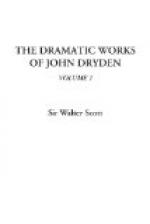The favourite comedies therefore, after the Restoration, were such as depended rather upon the intricacy than the probability of the plot; rather upon the vivacity and liveliness, than on the natural expression of the dialogue; and, finally, rather upon extravagant and grotesque conception of character, than upon its being pointedly delineated, and accurately supported through the representation. These particulars, in which the comedies of Charles the Second’s reign differ from the example set by Shakespeare, Massinger and Beaumont and Fletcher, seem to have been derived from the Spanish model. But the taste of the age was too cultivated to follow the stage of Madrid, in introducing, or, to speak more accurately, in reviving, the character of the gracioso, or clown, upon that of London.[9] Something of foreign manners may be traced in the licence assumed by valets and domestics in the English comedy; a freedom which at no time made a part of our national manners, though something like it may still be traced upon the Continent. These seem to be the leading characteristics of the comedies of Charles the Second’s reign, in which the rules of the ancients were totally disregarded. It were to be wished that the authors could have been exculpated from an heavier charge,—that of assisting to corrupt the nation, by nourishing and fomenting their evil passions, as well as by indulging and pandering to their vices.
The theatres, after the Restoration, were limited to two in number; a restriction perhaps necessary, as the exclusive patent expresses it, in regard of the extraordinary licentiousness then used in dramatic representation; but for which no very good reason can be shown, when they are at least harmless, if not laudable places of amusement. One of these privileged theatres was placed under the direction of Sir William Davenant, whose sufferings in the royal cause merited a provision, and whose taste and talents had been directed towards the drama even during its proscription. He is said to have introduced moveable scenes upon the English stage; and, without entering into the dispute of how closely this is to be interpreted, we are certain that he added much to its splendour and decoration. His set of performers, which contained the famous Betterton, and others of great merit, was called the Duke’s Company. The other licensed theatre was placed under the direction of Thomas Killigrew, much famed by tradition for his colloquial wit, but the merit of whose good things evaporated so soon as he attempted to interweave them with comedy.[10] His performers formed what was entitled the King’s Company. With this last theatre Dryden particularly connected himself, by a contract to be hereafter mentioned. None of his earlier plays were acted by the Duke’s Company, unless those in which he had received assistance from others, whom he might think as well entitled as himself to prescribe the place of representation.




